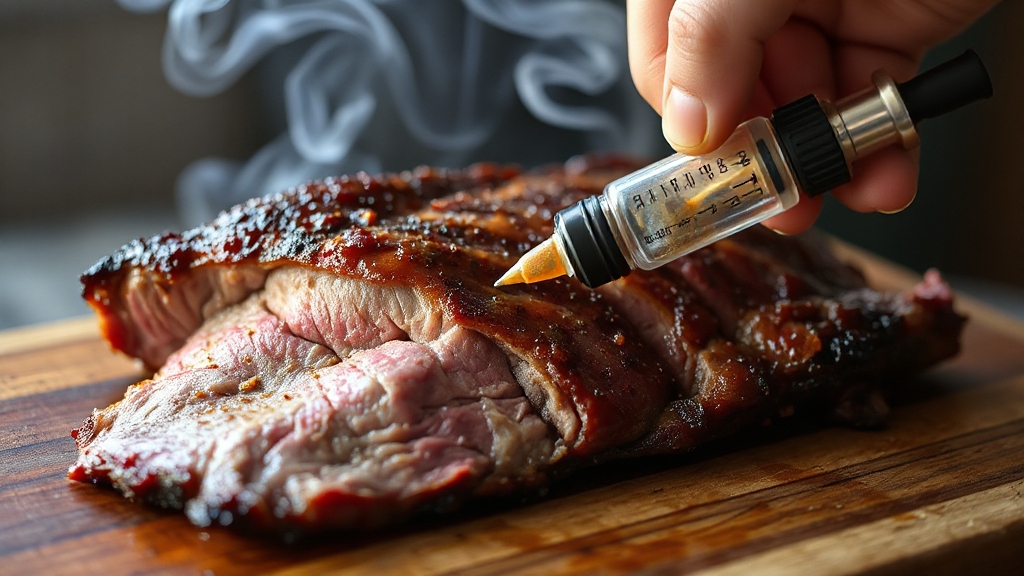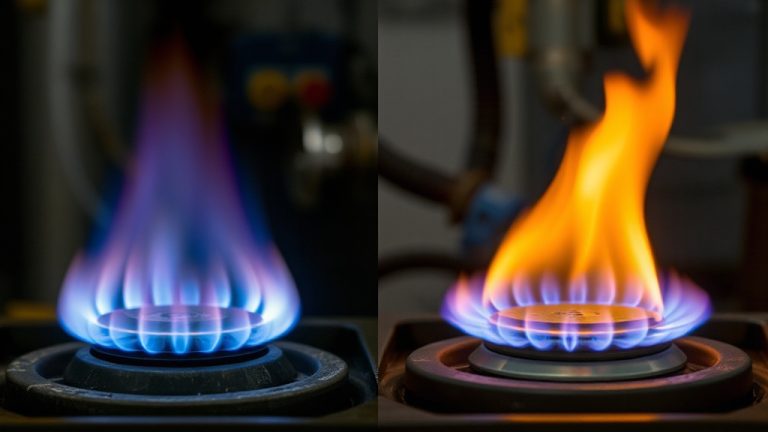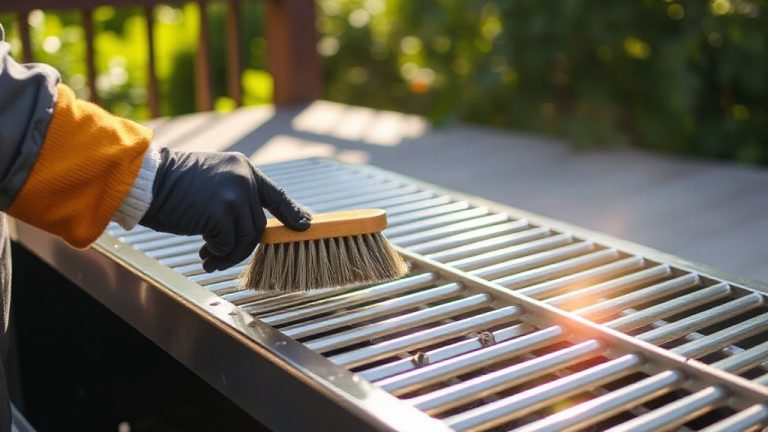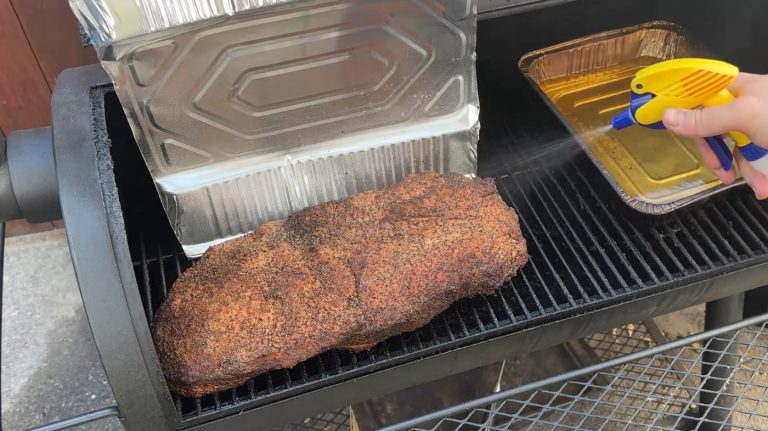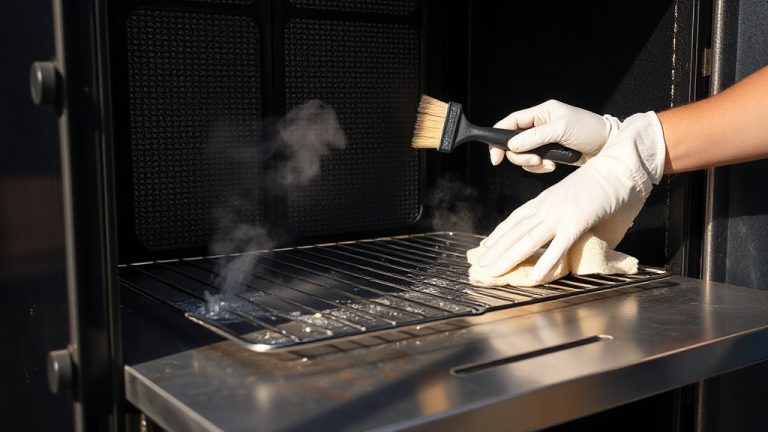Can You Inject Brisket While Cooking: Prevent Contamination
You can inject brisket while it’s cooking to enhance moisture and flavor, especially during long smokes around the 5-6 hour mark. Injecting mid-cook helps replenish lost juices but offers less flavor penetration than pre-cook injection.
Use a sanitized injector and inject slowly in a grid pattern to avoid leakage. Guarantee proper temperature control and hygiene to prevent contamination. For deeper tips on timing, techniques, and safety that optimize your brisket’s outcome, keep exploring these details.
Key Takeaways
- Yes, brisket can be injected during cooking, typically around 5-6 hours in, to add moisture in long smoking sessions.
- Injecting during cooking offers less flavor penetration compared to pre-cook injection but helps revitalize moisture.
- Use sterile needles and sanitized tools to prevent contamination when injecting brisket mid-cook.
- Ensure the brisket reaches a safe internal temperature of at least 195°F to eliminate pathogens after injection.
- Pre-cook injection remains preferred for even flavor distribution and tenderness over injecting while cooking.
Benefits of Injecting Brisket During Cooking
While cooking brisket, injecting it with a flavorful liquid considerably enhances moisture retention by delivering fats, oils, and seasonings deep into the meat’s interior. This injection hydrates muscle fibers, maintaining juiciness and preventing the lean flat cut from drying out or becoming tough.
Proper mixing of the injection solution, such as combining beef stock with a beef injection mixture, ensures effective infusion of flavors and moisture into the meat.
Managing internal temperature and moisture stability during cooking is crucial for optimal results, similar to how temperature management is important when mixing charcoal types. You’ll notice improved flavor penetration as salt and spices infuse beyond the surface, ensuring each bite has consistent seasoning.
Additionally, injected fats and salt promote connective tissue breakdown, tenderizing the brisket and reducing chew effort. This technique also allows precise flavor customization, letting you tailor blends without affecting the bark or smoke ring.
Finally, injection supports uniform cooking by stabilizing internal moisture and temperature, making it an invaluable method for consistent, high-quality brisket results during low-and-slow cooking. Using an injector to apply the mixture in a grid-like pattern ensures even distribution of flavors and moisture throughout the brisket.
Optimal Timing for Injecting Brisket
Because timing directly influences flavor absorption and moisture retention, choosing the most advantageous moment to inject your brisket is essential.
Injecting 12 hours before cooking allows flavors to penetrate deeply and promotes moisture retention during smoking. You can extend this to 24-48 hours if properly refrigerated, maximizing infusion but requiring strict food safety measures.
Many pitmasters prefer injecting the night before for optimal flavor absorption. Wrapping and resting techniques help maintain moisture and improve tenderness during the post-injection phase.
Injecting 1-2 hours prior still enhances flavor, ideal when time is limited, though absorption is more surface-level.
Alternatively, injecting during the cook—around 5-6 hours in—can revitalize moisture in longer smokes, especially with larger cuts, using butter or broth-based mixes. Post-injection holding time affects results; longer resting improves flavor depth but must balance safety.
Select timing based on your schedule, brisket size, and desired flavor intensity for suitable results. Ensuring proper temperature control during resting, such as using a preheated cooler, helps maintain food safety and enhances moisture retention.
Techniques for Injecting Brisket on the Smoker
Selecting when to inject your brisket sets the stage, but mastering the injection process itself guarantees even flavor distribution and moisture retention.
Use a meat injector loaded fully with marinade, injecting in a grid pattern spaced 1–2 inches apart. Target the flat muscle, the leanest part prone to drying. Inject slowly while withdrawing the needle to ensure internal dispersion without leakage.
Flip the brisket and repeat to cover both sides. Wipe excess marinade to avoid washing rub off. Remember that using a meat injector with a large needle is essential for effective injection and ease of use.
Maintaining steady moisture levels inside the meat is crucial, especially when smoking in high humidity conditions, as it affects flavor absorption and texture.
| Step | Action | Purpose |
|---|---|---|
| 1 | Insert needle deep | Maximize flavor penetration |
| 2 | Inject slowly on withdrawal | Prevent leakage |
| 3 | Repeat on both sides | Even moisture distribution |
Best Injection Mixtures for Mid-Cook Flavor Boost
When you inject brisket mid-cook, choosing the right mixture is critical to enhance flavor without overpowering the meat or disrupting the bark.
Opt for lighter, broth-based injections with beef stock as the foundation, combined with subtle umami enhancers like Worcestershire or soy sauce. This method helps to deliver flavor and moisture deep into the meat quickly, ensuring the brisket remains juicy throughout the smoking process.
Consider the fat content of your injection mixture to complement the brisket’s marbling and maintain tenderness. Incorporate garlic and onion powders sparingly to maintain aromatic balance. Minimize sugar content to avoid excessive sweetness mid-cook, which can interfere with bark development.
Adding a small amount of butter or rendered fat improves mouthfeel and moisture retention. Before injecting, simmer ingredients briefly to meld flavors and dissolve solids, then cool to avoid premature cooking.
Inject evenly in a grid pattern to ensure distribution. This approach revitalizes moisture and intensifies flavor while preserving the brisket’s texture and smoke ring integrity.
Potential Risks and How to Avoid Them
You need to prioritize food safety by sterilizing injection equipment and using properly prepared liquids to prevent bacterial contamination. Avoid cross-contamination by not reusing syringes or injection solutions without thorough sanitation.
Maintaining proper temperature control during and after injection also minimizes pathogen growth risks. Additionally, understanding the combustion and ignition characteristics of propane can help ensure safe heating practices when using propane-fueled smokers or grills.
Food Safety Concerns
Although injecting brisket enhances flavor and moisture, it introduces specific food safety risks that you must manage carefully.
Piercing the meat transfers surface bacteria like Listeria, Salmonella, and E. coli internally, potentially promoting their growth if cooking temperatures aren’t promptly reached. Using wood with high resin content, such as pine wood, can produce strong odors and potentially affect food safety when smoking brisket.
You need to guarantee the brisket reaches at least 195°F, staying above 140°F to effectively kill pathogens. Smoking at lower temperatures for extended periods can increase risk, so maintaining proper timing is critical to avoid prolonged exposure to the danger zone.
Injecting cold or improperly thawed meat extends time in the danger zone (40°F–140°F), increasing bacterial risk. Always disinfect injection equipment with boiling water or alcohol before use, thoroughly cleaning needles and syringes to prevent contamination.
Inject just before cooking and handle meat under sanitized conditions to limit bacterial proliferation. Avoid multiple injections or probing during cooking to minimize contamination and temperature disruption.
Preventing Cross-Contamination
Managing food safety during brisket injection extends beyond proper cooking temperatures; preventing cross-contamination plays a significant role in ensuring meat safety.
You must sterilize needles, avoid surface contact with raw poultry, and sanitize all tools frequently. Reusing injection equipment without cleaning transfers bacteria like E. coli deep inside the meat.
Additionally, heating rendered fat used in injections may pose safety concerns that require careful handling to maintain food safety standards. Using food-grade materials and proper wrapping techniques after injection can also help maintain meat safety and quality.
| Risk Source | Cause | Prevention |
|---|---|---|
| Contaminated needles | Reuse without sanitation | Use sterile, single-use needles |
| Handling surfaces | Cross-contact from raw meats | Separate sanitized prep areas |
| Splash and aerosolization | Washing raw meat | Avoid washing; handle carefully |
Comparing Injection Before vs. During Cooking
When deciding between injecting brisket before or during cooking, contemplate how timing affects flavor penetration and moisture retention. Injecting 8-12 hours prior allows the marinade to evenly diffuse, enhancing juiciness and flavor.
This approach also aligns with maintaining a consistent smoker temperature, which is crucial for even cooking and optimal moisture retention. Injecting during cooking is less documented and generally offers no proven advantage.
Consider these key points:
- Pre-cook injection permits thorough marinade absorption, improving moisture retention. This marination period allows the brisket to fully absorb the injection ingredients.
- During-cook injection risks uneven distribution and less flavor impact.
- Injecting early can reduce the internal temperature needed for tenderness.
- Most experts recommend pre-cook injection for consistent results and juicier brisket.
Frequently Asked Questions
Can Injecting Brisket During Cooking Affect Smoke Ring Formation?
Injecting brisket during cooking won’t affect smoke ring formation because the ring forms from surface reactions with combustion gases, not internal liquids. The smoke ring develops in the first 1-2 hours below 135-140°F, and injection doesn’t extend this window.
While injecting can improve tenderness and moisture, it doesn’t influence the nitric oxide binding to myoglobin near the surface that creates the ring, so injecting mid-cook won’t change its appearance.
Does Injecting Mid-Cook Alter Cooking Time Significantly?
You won’t see much change in cooking time because injecting 1-2 cups mid-cook barely affects the brisket’s thermal mass. The heat penetration and internal temperature rise depend mostly on the meat’s size and smoker conditions, not added moisture.
While it might slightly delay bark formation if surface moisture builds up, this impact is usually negligible. So, injecting during cooking doesn’t markedly alter how long you’ll need to smoke your brisket.
What Tools Are Best for Injecting Brisket on a Hot Smoker?
You’ll want a durable injector like the OXO Flavor Injector with its smaller red-tipped needle for precise, low-damage penetration. Stainless steel needles are essential for longevity and easy cleaning. Look for a comfortable grip to steady your hand during long sessions.
Also, use a sharp trimming knife to prep the brisket surface, heat-resistant gloves for safety, and cleaning brushes to maintain your injector. These tools optimize marinade delivery and make certain flavor in your hot smoker.
How Often Can You Safely Inject Brisket While Cooking?
You should inject brisket only once before cooking to maintain safety and quality. Injecting multiple times during cooking risks contaminating the meat by introducing bacteria through repeated punctures and can damage the bark and rub.
A single, thorough injection evenly distributes moisture and flavor, preserving the brisket’s texture and juiciness. Avoid injecting while the brisket is hot to prevent health risks and maintain ideal cooking results.
Can Injecting During Cooking Cause Flare-Ups or Safety Hazards?
Injecting brisket during cooking can increase flare-up risks if juices drip onto heat sources, but careful injection at low temperatures minimizes this. You must use sanitized tools and sterile liquids to avoid bacterial contamination.
Frequent piercing also raises safety concerns by allowing bacteria inside and causing temperature fluctuations. Inject at least 3 hours before cooking, maintain cooking temps above 140°F quickly, and limit injection frequency to ensure safety and reduce flare-ups.
Don’t Drown the Meat: Creating a Balanced Injection Mix
Injecting brisket during cooking can elevate flavor and moisture, but timing and technique matter. Doing it mid-cook allows deeper absorption without losing initial bark development. Use balanced injection mixtures to avoid overpowering the meat.
Remember, “a stitch in time saves nine”—injecting too late or improperly risks uneven texture or spoilage. Master these technical details, and your brisket will turn out tender, juicy, and packed with flavor every time you fire up the smoker.
